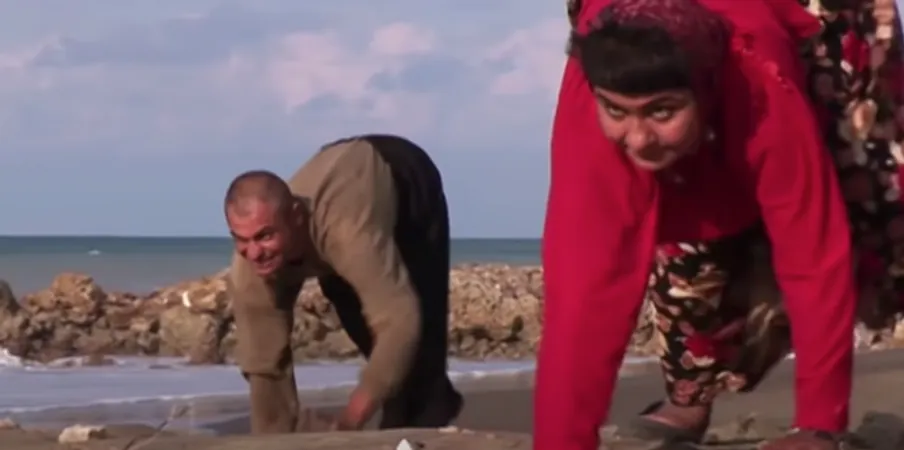
The Ulas Family: The Human Anomaly That Challenges Our Understanding of Evolution
2024-10-11
Author: Kai
Introduction
In a world where family dynamics can range from the ordinary to the extraordinary, the Ulas family from a remote village in Turkey has captivated scientists and the public alike with their unusual mode of locomotion—walking on all fours. This remarkable trait has led experts to classify them as true anomalies within the human species.
Historical Context
The fascination with the Ulas family dates back to the early 2000s when a scientific paper documented five of their siblings who engage in a peculiar bear-crawl style of movement. Professor Nicholas Humphrey, an evolutionary psychologist from the London School of Economics, became particularly intrigued by theirs—a walking style not seen in any modern adult humans.
Family Dynamics
The Ulas family, consisting of a staggering 18 children, presents a peculiar case; only six of the siblings exhibit this unique quadrupedalism. This phenomenon raises critical questions within the scientific community regarding its origins and implications in the realm of human evolution.
Scientific Investigation
In a thought-provoking documentary aired by 60 Minutes Australia in 2018, Humphrey shared his astonishment upon meeting the family. “I never expected that even under the most extraordinary scientific fantasy that modern human beings could return to an animal state,” he expressed. He outlined what makes humans distinct—our bipedalism and communicative capabilities—and pointed out how the Ulas siblings appear to blur the lines between man and our primate relatives.
The Missing Link?
Described as 'the missing link between man and ape,' the Ulas family continues to puzzle researchers. Despite various theories, no consensus exists on the exact cause of their quadrapedalism. While some scientists speculate a genetic anomaly might explain their condition—'undoing the last three million years of evolution'—others argue that there is no single gene responsible for upright walking and propose alternative explanations.
Brain Function and Movement
Further investigation revealed that all affected siblings exhibit a specific type of brain damage; their cerebellar vermis is shrunken, indicating potential links to their unusual walking. However, this alone does not account for their quadrupedal movement, as many individuals with a damaged cerebellum can still walk upright.
Comparative Analysis with Primates
A key difference between the Ulas siblings and our primate relatives lies in their walking style. While chimpanzees traverse on their knuckles, the Ulas children utilize the palms of their hands, keeping their fingers agile and functional, which allows them to perform intricate tasks like crochet and embroidery.
Evolutionary Insights
Humphrey suggests that the Ulas family's quadrupedalism may reflect an evolutionary stage, offering insights into how early humans might have walked. He posited that by retaining dexterity in their fingers, they may have been able to manipulate tools, which played a vital role in our species' development.
Environmental Influences
Curiously, environmental factors might contribute to the Ulas family's unique circumstances. Growing up in a setting without adequate healthcare and support for disabled individuals hindered their ability to transition to upright walking. After providing the siblings with walking frames, Humphrey witnessed a remarkable transformation, enabling them to walk upright for the first time with evident delight.
Conclusion
Through this experience, he witnessed the enduring human spirit in overcoming incredible adversity. “It is humbling to see how individuals can triumph against all odds and maintain their sense of self,” he reflected. As scientific discourse continues, the Ulas family remains a poignant reminder of the intricacies of human evolution and the unyielding will of the human spirit. As researchers visit and study this family, the world watches with bated breath, eager to gain insight into the curious phenomenon that challenges our very understanding of what it means to be human.

 Brasil (PT)
Brasil (PT)
 Canada (EN)
Canada (EN)
 Chile (ES)
Chile (ES)
 España (ES)
España (ES)
 France (FR)
France (FR)
 Hong Kong (EN)
Hong Kong (EN)
 Italia (IT)
Italia (IT)
 日本 (JA)
日本 (JA)
 Magyarország (HU)
Magyarország (HU)
 Norge (NO)
Norge (NO)
 Polska (PL)
Polska (PL)
 Schweiz (DE)
Schweiz (DE)
 Singapore (EN)
Singapore (EN)
 Sverige (SV)
Sverige (SV)
 Suomi (FI)
Suomi (FI)
 Türkiye (TR)
Türkiye (TR)